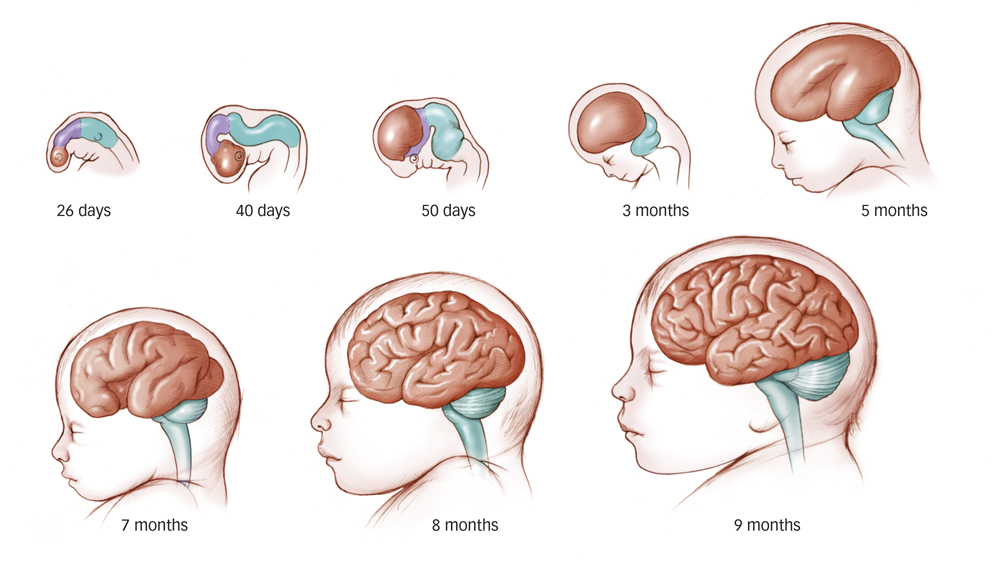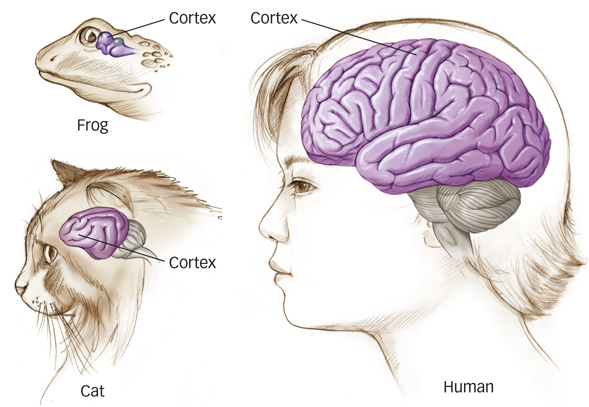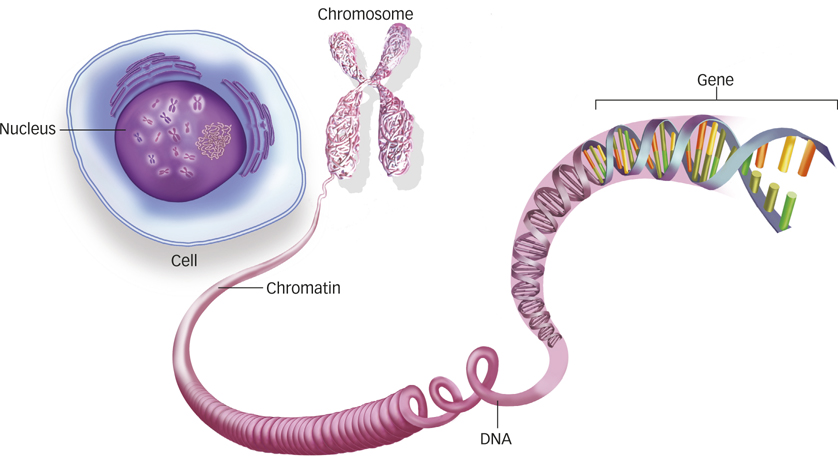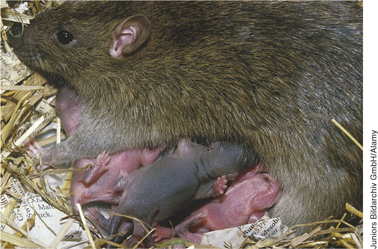3.5 The Development and Evolution of Nervous Systems
Far from being a single, elegant machine, the human brain is instead a system comprised of many distinct components that have been added at different times during the course of evolution. The human species has retained what worked best in earlier versions of the brain, then added bits and pieces to get us to our present state through evolution.
To understand the central nervous system, it is helpful to consider two aspects of its development. Prenatal development (growth from conception to birth) reveals how the nervous system develops and changes within each member of a species. Evolutionary development reveals how the nervous system in humans evolved and adapted from other species.
Prenatal Development of the Central Nervous System
What are the stages of development of the embryonic brain?
The nervous system is the first major bodily system to take form in an embryo (Moore, 1977). It begins to develop within the 3rd week after fertilization, when the embryo is still in the shape of a sphere. Initially, a ridge forms on one side of the sphere and then builds up at its edges to become a deep groove. The ridges fold together and fuse to enclose the groove, forming a structure called the neural tube. The tail end of the neural tube will remain a tube, and as the embryo grows larger, this tube forms the basis of the spinal cord. The tube expands at the opposite end, so that by the 4th week, the three basic levels of the brain are visible. During the 5th week, the forebrain and hindbrain further differentiate into subdivisions. During the 7th week and later, the forebrain expands considerably to form the cerebral hemispheres.
78
As the embryonic brain continues to grow, each subdivision folds onto the next one and begins to form the structures easily visible in the adult brain (see FIGURE 3.18). The hindbrain forms the cerebellum and medulla, the midbrain forms the tectum and the tegmentum, and the forebrain subdivides further, separating the thalamus and hypothalamus from the cerebral hemispheres. In about half the time it takes you to complete a 15-

Evolutionary Development of the Central Nervous System

The central nervous system evolved from the very simple one found in simple animals to the elaborate nervous system in humans today. Even the simplest animals have sensory neurons and motor neurons for responding to the environment (Shepherd, 1988). For example, single-

What distinguishes the brain of a mammal from the brain of an amphibian?
During the course of evolution, a major split in the organization of the nervous system occurred between invertebrate animals (those without a spinal column) and vertebrate animals (those with a spinal column). In all vertebrates, the central nervous system is organized into a hierarchy: The lower levels of the brain and spinal cord execute simpler functions, while the higher levels of the nervous system perform more complex functions. As you saw earlier, in humans, reflexes are accomplished in the spinal cord. At the next level, the midbrain executes the more complex task of orienting toward an important stimulus in the environment. Finally, a more complex task, such as imagining what your life will be like 20 years from now, is performed in the forebrain (Addis, Wong, & Schacter, 2007; Schacter et al., 2012; Szpunar, Watson, & McDermott, 2007).
79
The forebrain undergoes further evolutionary advances in vertebrates. In lower vertebrate species such as amphibians (frogs and newts), the forebrain consists only of small clusters of neurons at the end of the neural tube. In higher vertebrates, including reptiles, birds, and mammals, the forebrain is much larger, and it evolves in two different patterns. Reptiles and birds have almost no cerebral cortex. By contrast, mammals have a highly developed cerebral cortex, which develops multiple areas that serve a broad range of higher mental functions. This forebrain development has reached its peak—
Genes and Epigenetics
Is it genetics (nature) or the environment (nurture) that reigns supreme in directing a person’s behavior? The emerging picture from current research is that both nature and nurture play a role in directing behavior, and the focus has shifted to examining the interaction of the two rather than the absolute contributions of either alone (Gottesman & Hanson, 2005; Rutter & Silberg, 2002; Zhang & Meaney, 2010).
What Are Genes?
A gene is the major unit of hereditary transmission. Historically, the term gene has been used to refer to two distinct but related concepts. Genes are sections on a strand of DNA (deoxyribonucleic acid) that are organized into large threads called chromosomes, strands of DNA wound around each other in a double-
gene
The major unit of hereditary transmission.
chromosomes
Strands of DNA wound around each other in a double-

As a species, we share about 99% of the same DNA (and almost as much with other apes), but there is a portion of DNA that varies across individuals. Children share more of this variable portion of DNA with their parents than with more distant relatives or with nonrelatives: Such children share half their genes with each parent, a quarter of their genes with their grandparents, an eighth of their genes with cousins, and so on. The probability of sharing genes is called degree of relatedness. The most genetically related people are monozygotic twins (also called identical twins), who develop from the splitting of a single fertilized egg and therefore share 100% of their genes. Dizygotic twins (fraternal twins) develop from two separate fertilized eggs and share 50% of their genes, the same as any two siblings born separately.
Why do dizygotic twins share 50% of their genes, just like siblings born separately?
80
Many researchers have tried to determine the relative influence of genetics on behavior. One way to do this is to compare a trait shown by monozygotic twins with that same trait among dizygotic twins. This type of research usually enlists twins who were raised in the same household, so that the impact of their environment (their socioeconomic status, access to education, parental child-
As an example, the likelihood that the dizygotic twin of a person who has schizophrenia (a mental disorder we’ll discuss in greater detail in the Psychological Disorders chapter) will also develop schizophrenia is 27%. However, this statistic rises to 50% for monozygotic twins. That sounds frighteningly high … until you realize that 50% of monozygotic twins of people with schizophrenia will not develop the disorder. That means that environmental influences must play a role too. In short, genetics can contribute to the development, likelihood, or onset of a variety of traits. But a more complete picture of genetic influences on behavior must always take the environmental context into consideration. Genes express themselves within an environment, not in isolation.

JBphoto1/Alamy
81
A Role for Epigenetics
The idea that genes are expressed within an environment is central to an important and rapidly growing area of research known as epigenetics: environmental influences that determine whether or not genes are expressed, or the degree to which they are expressed, without altering the basic DNA sequences that constitute the genes themselves. To understand how epigenetic influences work, think about DNA as analogous to a script for a play or a movie. The biologist Nessa Carey (2012) offers the example of Shakespeare’s Romeo and Juliet, which was made into a movie in 1936 starring Leslie Howard and Norma Shearer, and in 1996 starring Leonardo DiCaprio and Claire Danes. Shakespeare’s script formed the basis of both films, but the directors of the two films used the script in different ways, and the actors in the two films gave different performances. Thus, the final products were different from one another, even though Shakespeare’s original script still exists.
epigenetics
Environmental influences that determine whether or not genes are expressed, or the degree to which they are expressed, without altering the basic DNA sequences that constitute the genes themselves.
Similarly, epigenetics provides a way for the environment to influence gene expression—
Hot Science: Epigenetics and the Persisting Effects of Early Experiences
Epigenetics and the Persisting Effects of Early Experiences
An exciting series of studies show that epigenetic processes play a critical role in the long-
Back in the 1990s, Meaney’s lab found that there are notable differences in the mothering styles of rats (Francis et al., 1999; Liu et al., 1997): Some mothers spend a lot of time licking and grooming their young pups (“attentive” mothers), whereas others spend little time doing so (“inattentive” mothers). The researchers found that pups of attentive mothers are much less fearful as adults when placed in stressful situations than the adult pups of inattentive mothers. Later, when placed in fear-

But can early experiences affect adult behavior in humans, too? Meaney’s group examined samples taken from the brains of 24 men who had committed suicide around the age of 35 (McGowan et al., 2009). Twelve of those men had a history of childhood abuse, and 12 did not. Strikingly, the researchers found evidence for epigenetic changes in the 12 men who had suffered childhood abuse and committed suicide compared with the 12 men who had not been abused. And the specific changes in gene expression were very similar to those observed in adult pups of inattentive mothers. In other words, there seem to be similar epigenetic effects of adverse early experiences in rats and humans, suggesting that in order to understand the effects of early experiences on subsequent development and behavior, we need to look to the broad role played by epigenetic influences (Meaney & Ferguson-
82
SUMMARY QUIZ [3.5]
Question 3.13
| 1. | During the course of embryonic brain growth, the _____________ undergoes the greatest development. |
- cerebral cortex
- cerebellum
- tectum
- thalamus
a.
Question 3.14
| 2. | The first true central nervous system appeared in |
- flatworms.
- jellyfish.
- protozoa.
- early primates.
a.
Question 3.15
| 3. | Genes set the _____________ that a given individual can express. |
- individual characteristics
- range of variation
- environmental possibilities
- behavioral standards
b.